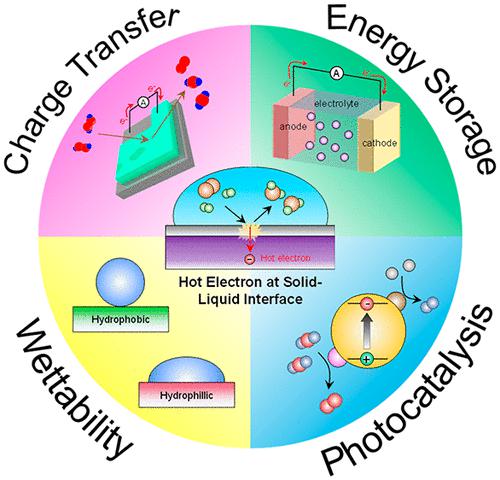当前位置:
X-MOL 学术
›
J. Phys. Chem. Lett.
›
论文详情
Our official English website, www.x-mol.net, welcomes your
feedback! (Note: you will need to create a separate account there.)
Hot Electron Phenomena at Solid–Liquid Interfaces
The Journal of Physical Chemistry Letters ( IF 4.8 ) Pub Date : 2022-10-04 , DOI: 10.1021/acs.jpclett.2c02319 Si Woo Lee 1 , Beomjoon Jeon 2, 3 , Hyosun Lee 4 , Jeong Young Park 2, 3
The Journal of Physical Chemistry Letters ( IF 4.8 ) Pub Date : 2022-10-04 , DOI: 10.1021/acs.jpclett.2c02319 Si Woo Lee 1 , Beomjoon Jeon 2, 3 , Hyosun Lee 4 , Jeong Young Park 2, 3
Affiliation

|
Understanding the role of energy dissipation and charge transfer under exothermic chemical reactions on metal catalyst surfaces is important for elucidating the fundamental phenomena at solid–gas and solid–liquid interfaces. Recently, many surface chemistry studies have been conducted on the solid–liquid interface, so correlating electronic excitation in the liquid-phase with the reaction mechanism plays a crucial role in heterogeneous catalysis. In this review, we introduce the detection principle of electron transfer at the solid–liquid interface by developing cutting-edge technologies with metal–semiconductor Schottky nanodiodes. The kinetics of hot electron excitation are well correlated with the reaction rates, demonstrating that the operando method for understanding nonadiabatic interactions is helpful in studying the reaction mechanism of surface molecular processes. In addition to the detection of hot electrons excited by a catalytic reaction, we highlight recent results on how the transfer of the hot electrons influences surface chemical and photoelectrochemical reactions.
中文翻译:

固液界面的热电子现象
了解金属催化剂表面放热化学反应下能量耗散和电荷转移的作用对于阐明固-气和固-液界面的基本现象很重要。最近,许多表面化学研究已经在固液界面上进行,因此将液相中的电子激发与反应机理相关联在多相催化中起着至关重要的作用。在这篇综述中,我们通过开发金属-半导体肖特基纳米二极管的尖端技术,介绍了固液界面电子转移的检测原理。热电子激发的动力学与反应速率密切相关,表明操作了解非绝热相互作用的方法有助于研究表面分子过程的反应机理。除了检测由催化反应激发的热电子外,我们还重点介绍了热电子转移如何影响表面化学和光电化学反应的最新结果。
更新日期:2022-10-04
中文翻译:

固液界面的热电子现象
了解金属催化剂表面放热化学反应下能量耗散和电荷转移的作用对于阐明固-气和固-液界面的基本现象很重要。最近,许多表面化学研究已经在固液界面上进行,因此将液相中的电子激发与反应机理相关联在多相催化中起着至关重要的作用。在这篇综述中,我们通过开发金属-半导体肖特基纳米二极管的尖端技术,介绍了固液界面电子转移的检测原理。热电子激发的动力学与反应速率密切相关,表明操作了解非绝热相互作用的方法有助于研究表面分子过程的反应机理。除了检测由催化反应激发的热电子外,我们还重点介绍了热电子转移如何影响表面化学和光电化学反应的最新结果。

































 京公网安备 11010802027423号
京公网安备 11010802027423号